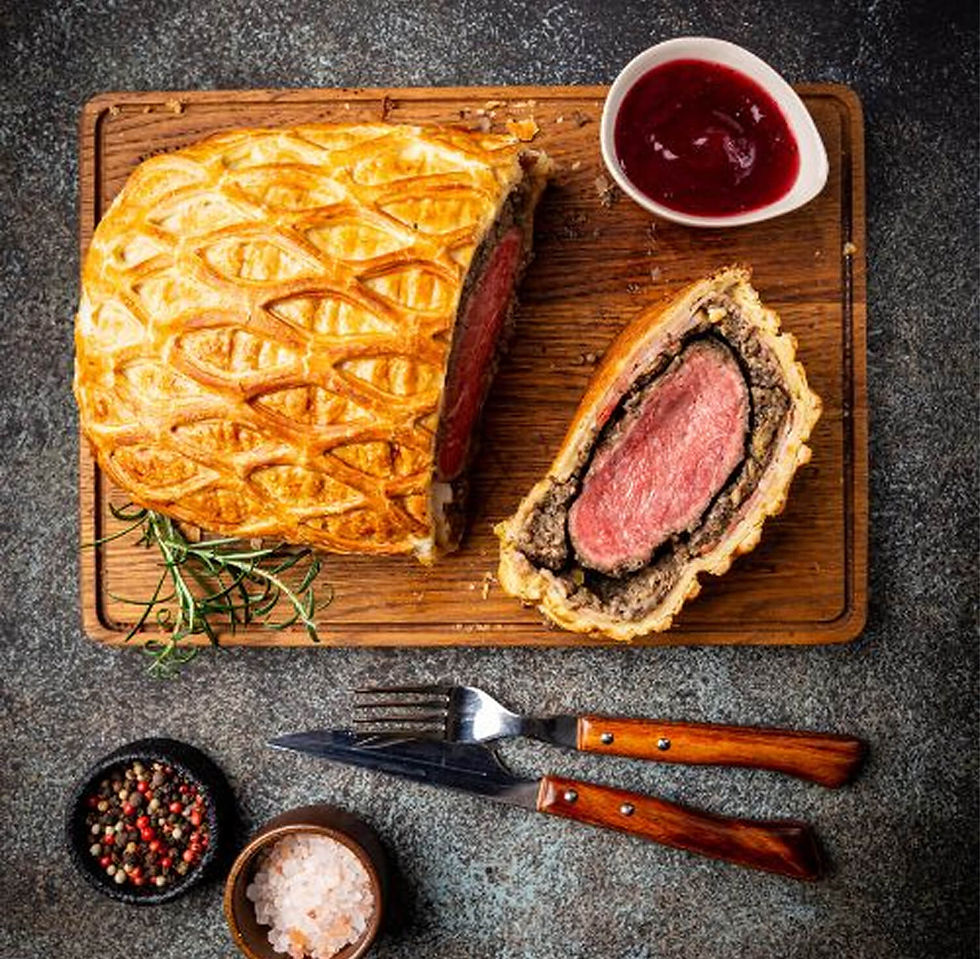Shrimp and Crab Boil
- ckcallighan20209
- Jan 26, 2024
- 6 min read

My husband’s birthday is early in January, and he often requests Shrimp and Crab Boil for his birthday dinner. I must admit the first time I made this was a bit intimidating, but after making it several times, I’ve got it down pat.
I’ve read dozens of recipes for shrimp and crab boil, and most call for using only one kettle. I have come to believe that using two large kettles yields the best results. I like to make sure all the crab and shrimp are immersed in broth; therefore, I have doubled the flavorings so there is enough for two kettles. If you reduce this recipe so it serves only 2 to 4, bear that in mind.
The hardest thing about making a shrimp and crab boil is timing—you don’t want to overcook any of the ingredients. New potatoes should cook no more than 20 minutes, and corn no more than 10 minutes. Crab should be cooked about 6 to 8 minutes; and shrimp 2 to 3 minutes. My directions take that into account, so if you find the timing of adding these ingredients strange, that is the rationale.
When making this recipe, you can use either snow crab clusters or king crab legs. Snow crab is less expensive. I have included amounts to purchase for both, so you can let your budget determine which type of crab you use. I purchase the largest shrimp available for this recipe.
I made Shrimp and Crab Boil again this year for Russ’ birthday. My grandson, Aiden, said my recipe was better than Joe’s Crab Shack. My daughter, Alisa, who is vegetarian but will eat fish, chowed down. (She did pick out the sausage.) The best part of our evening, however, was a family Texas Holdem tournament after dinner.
Shrimp and Crab Boil
Serves 8
This is a messy, hands-on meal. Be sure to have lots of napkins available and an empty bowl in the middle of the table for discarded shells.
4 tablespoons extra virgin olive oil
16 ounces andouille sausage, cut into 1-inch rounds
5 to 6 shallots, peeled and sliced lengthwise
6 quarts water (24 cups)
2 teaspoons hot sauce
6 tablespoons crab boil spice mix
6 bay leaves
2 tablespoons salt
2 teaspoons ground black pepper
2 jalapeños, minced
1 ½ pounds new potatoes
4 ears corn, shucked and cut into halves
3 ½ pounds snow crab clusters, thawed
or
8 king crab legs, thawed (about 4 pounds)
2 pounds jumbo shrimp, heads removed, shells on, de-veined, uncooked
For the garnish and to serve:
½ cup fresh parsley, minced
4 lemons, quartered
Tarragon butter (recipe follows)
Using two large kettles, place 2 tablespoons olive oil in each kettle over a medium heat. When the oil sizzles, place half the sausage and half the shallots in each kettle. Sauté until lightly browned, about 5 minutes.
To each kettle, add 12 cups water, 1 teaspoon hot sauce, 3 tablespoons crab boil, 3 bay leaves, 1 tablespoon salt, 1 teaspoon pepper, and half the jalapeños and bring to a boil.
To each kettle, add half the potatoes, cover, reduce the heat to medium, and cook 10 minutes.
Divide corn equally among the kettles and cook an additional 2 minutes.
Divide crab equally between the kettles, bring to a boil, and cook another 5 minutes.
Add shrimp equally to the kettles and cook another 2 to 3 minutes, or until shrimp are pink and curled.
Strain the boil through a colander.
Place in two large serving dishes. Garnish with parsley and lemon wedges. Serve with tarragon butter.
For the tarragon butter:
1 cup butter
6 sprigs fresh tarragon, divided
2 teaspoons lemon zest (1 lemon)
2 teaspoons lemon juice
Salt to taste
In a small saucepan, place butter and melt over medium low heat. Add 4 tarragon sprigs and lemon zest and stir to combine. Remove from the heat and let stand 15 minutes.
Finely chop the leaves from the remaining 2 tarragon sprigs. Remove tarragon sprigs from the melted butter. Rewarm butter over a low heat. Add chopped tarragon and lemon juice and stir to combine. Season to taste with salt.
Tips on buying shrimp: Fresh versus Frozen. Fishermen put shrimp on ice as soon as they are caught. This preserves the shrimp, freezing them so they are just-caught fresh until they are thawed. The fresh shrimp you see on ice in the seafood counter at your supermarket were most likely once frozen and are thawing in the counter. The longer they are in the counter, the less fresh they will be. Unless you know that the fresh shrimp you are buying is fresh off the boat, frozen shrimp is a better choice.
Wild-Caught or Farm-Raised: Wild-caught shrimp have a sharper, more shrimpy taste; however, they are pricier and harder to find. Ninety percent of shrimp sold in the United States is imported from Southeast Asia, Ecuador, and India; and the majority of that is farm-raised. Your supermarket is required to divulge the country of origin and whether shrimp is wild or farmed. Check the label. If you have doubts, farm-raised shrimp cultivated under cleaner standards will bear a “Best Aquaculture Practices” label. The certification label to look for when buying wild shrimp is “Marine Stewardship Council Approved.”
The most common imported shrimp sold in the supermarket are white vannemei and tiger shrimp from Asia. The most common domestic varieties are white and pink shrimp from the Gulf of Mexico. If I have a choice, I prefer pink shrimp.
Do not purchase frozen shrimp that have dry spots on their shells. This is a sign of freezer burn. Except for the black tiger variety of shrimp, black spots on shells are an indication of spoilage. Signs of yellow or grit on the shells could mean the shrimp have been bleached to remove black spots. Avoid shrimp that smell like ammonia or feel soft or slimy.
Tips on de-veining shrimp: Unless you are cooking with very small shrimp, they must be de-veined. The intestinal tract on medium to large shrimp runs down their back and is quite unappetizing. To de-vein shrimp, hold them under a slow stream of cold water and run the tip of an ice pick or sharp knife down their back, scraping out the intestine, yet leaving the shrimp intact. Rinse gently to remove any black from the shrimp.
Tips on buying unsoaked shrimp: Shrimp is often soaked in a solution of water and tripolyphosphate. This does extend its shelf life but hurts its flavor. If available, buy the unsoaked or “dry” variety. They have a superior taste. Your supermarket is required by law to tell you whether fish has been soaked in this solution.
Tips on buying crab: You can purchase crab either alive or cooked and processed—picked crabmeat or crack-and-eat legs. If you are buying live crab, it should be alive. If you touch it and it doesn’t move, pass. Never buy dead raw crab.
Cooked, ready-to-eat crab is available at your supermarket either fresh, frozen, or pasteurized in cans. Crab should feel cold to the touch when you purchase it. Any exposed meat should be white in color. If you are buying frozen, check the package for ice crystals. This is a sign of freezer burn.
Tips on storing crab: If you purchase live crab, use it the day you buy it. To store live crab until you cook it, place it in an open container lined with wet newspaper and store it briefly in your refrigerator or a cooler. Keep live crab moist and cool but not wet.
Fresh crabmeat should be refrigerated and eaten within two days of purchase or frozen. Keep frozen crab frozen until you are ready to heat it.
Tips on thawing crab legs: You can thaw frozen crab legs by placing them in the refrigerator overnight (about 8 hours) or place them in your sink and run cold water over them. If you thaw them in your refrigerator, place them on a rack in a water-tight container so that any water drains to the bottom during defrosting.
Carol Ann

Carol Ann Kates is the award-winning author of cookbook, Secret Recipes from the Corner Market and Grocery Shopping Secrets. She’s an expert in how to shop, select, and store produce for maximizing home cooking outcomes and minimizing time and money spent. As a former supermarket and deli operator, Carol Ann shares grocery-insider wisdom—the same expertise you used to receive when patronizing a mom-and-pop establishment. Contact her at CarolAnn@CarolAnnKates.com and explore her website, www.CarolAnnKates.com.
Copyright 2024 All Rights Reserved Carol Ann Kates
1
Searing the Beef
Sear beef fillets on high heat for 2 minutes per side to form a golden crust. Let it cool before proceeding to keep the beef tender.
1
Searing the Beef
Sear beef fillets on high heat for 2 minutes per side to form a golden crust. Let it cool before proceeding to keep the beef tender.
1
Searing the Beef
Sear beef fillets on high heat for 2 minutes per side to form a golden crust. Let it cool before proceeding to keep the beef tender.
1
Searing the Beef
Sear beef fillets on high heat for 2 minutes per side to form a golden crust. Let it cool before proceeding to keep the beef tender.
Notes



1
Season the good fresh beef fillets with salt and black pepper. Heat olive oil in a pan over high heat and sear the fillets for 2 minutes per side until it fully browned. Remove the beef from the pan and brush with a thin layer of mustard. Let it cool.



1
Season the good fresh beef fillets with salt and black pepper. Heat olive oil in a pan over high heat and sear the fillets for 2 minutes per side until it fully browned. Remove the beef from the pan and brush with a thin layer of mustard. Let it cool.



1
Season the good fresh beef fillets with salt and black pepper. Heat olive oil in a pan over high heat and sear the fillets for 2 minutes per side until it fully browned. Remove the beef from the pan and brush with a thin layer of mustard. Let it cool.



1
Season the good fresh beef fillets with salt and black pepper. Heat olive oil in a pan over high heat and sear the fillets for 2 minutes per side until it fully browned. Remove the beef from the pan and brush with a thin layer of mustard. Let it cool.
Instructions
Quality Fresh 2 beef fillets ( approximately 14 ounces each )
Quality Fresh 2 beef fillets ( approximately 14 ounces each )
Quality Fresh 2 beef fillets ( approximately 14 ounces each )
Beef Wellington

Beef Wellington
Fusion Wizard - Rooftop Eatery in Tokyo
Author Name

Beef Wellington is a luxurious dish featuring tender beef fillet coated with a flavorful mushroom duxelles and wrapped in a golden, flaky puff pastry. Perfect for special occasions, this recipe combines rich flavors and impressive presentation, making it the ultimate centerpiece for any celebration.
Servings :
4 Servings
Calories:
813 calories / Serve
Prep Time
30 mins
Prep Time
30 mins
Prep Time
30 mins
Prep Time
30 mins










Comments